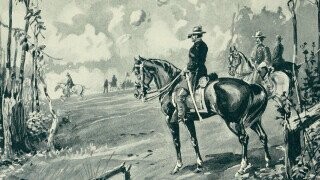The Civil War Had A Glow-In-The-Dark Battle

The Battle of Shiloh was one of the bloodiest of the early period of the American Civil War, and when the dust settled, there were thousands of wounded troops in need of attention. In a moment so surreal that it seems to be the stuff of legend, some of the wounds began to glow. And these glowing wounds may have saved lives.
In April 1862, General Ulysses S. Grant had forced Confederate troops deep into southwestern Tennessee. The Union men waited for additional soldiers before advancing further, but on April 6, Confederate forces launched a surprise attack on their camp. What followed was bloody, but the Union forces managed to survive until reinforcements arrived. Eventually, the Confederates retreated, but the battle was costly to both sides.
Between the two armies, there were more than 20,000 casualties and about 3,500 deaths in the Battle of Shiloh. At this point in the war, this was the deadliest battle, and medics were not prepared for the aftermath. Wounded men were left in the swampy, unexpectedly cold Tennessee mud for two full days before the battlefield was cleared.

The longer a casualty of battle had to wait, the worse his prognosis was. Two-thirds of deaths in the Civil War came from diseases. Harsh conditions led to weakened immune systems, and the medical attention they could receive was often not enough, limited by the scientific understanding of the time. A simple infection could turn deadly, as the soldier’s immune system couldn’t fight it. For some, though, their wounds did not fester or worsen as expected. Instead, they glowed a greenish-blue.
When the wounded finally received medical attention, medics also noticed the glowing wounds, but they also discovered something else. Troops with glowing wounds survived much more frequently than soldiers without the glow. Not only did they survive, but their wounds healed quicker. Medical knowledge during the Civil War was already limited enough anyway, but they had absolutely no possible explanation for the life-saving glow. It was dubbed “Angel’s Glow,” as there was no way to describe it other than miraculous.
For a scientific explanation, we have to jump to 2001. A 17-year-old named Bill Martin and his friend Jon Curtis began studying the Angel’s Glow after a trip to the battlefield. Martin’s mother was a scientist who studied glowing bacteria called Photorhabdus luminescens, or P. luminescens, and from what Martin understood on the subject, the case of Angel’s Glow seemed to match up.

P. luminescens live inside of nematodes in a sort of symbiotic relationship. Nematodes are parasitic, and when they find a host insect to feed on, they spew up P. luminescens. The bacteria then release chemicals to kill the host and any other bacteria or anything else that might be around. Nematodes and P. luminescens are not known to be harmful to humans, and in fact, they could not survive human body temperatures in normal conditions.
Except, the Battle of Shiloh was hardly a normal condition. Wounded soldiers were left in freezing conditions, and their lower body temperatures meant that P. luminescens could have survived. This theory also explains why soldiers with Angel’s Glow often fared better than others. The chemicals that P. Luminescens releases are not harmful to humans, but they would have killed off other microorganisms around the wound. Because of this, the glowing bacteria may have prevented infection.
Not all angels have wings. Some are disgusting, glowing microorganisms vomited up by other disgusting parasites. For troops in the Battle of Shiloh, these glowing bacteria may have saved the day.
Top Image: Wiki Commons